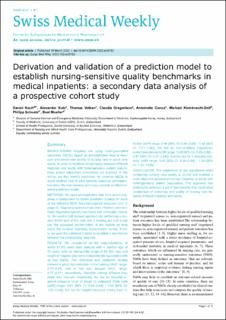Bitte benutzen Sie diese Kennung, um auf die Ressource zu verweisen:
https://doi.org/10.21256/zhaw-24726| Publikationstyp: | Beitrag in wissenschaftlicher Zeitschrift |
| Art der Begutachtung: | Peer review (Publikation) |
| Titel: | Derivation and validation of a prediction model to establish nursing-sensitive quality benchmarks in medical inpatients : a secondary data analysis of a prospective cohort study |
| Autor/-in: | Koch, Daniel Kutz, Alexander Volken, Thomas Gregoriano, Claudia Conca, Antoinette Kleinknecht-Dolf, Michael Schuetz, Philipp Mueller, Beat |
| et. al: | No |
| DOI: | 10.4414/smw.2022.w30152 10.21256/zhaw-24726 |
| Erschienen in: | Swiss Medical Weekly |
| Band(Heft): | 152 |
| Heft: | w30152 |
| Erscheinungsdatum: | 18-Mär-2022 |
| Verlag / Hrsg. Institution: | EMH Schweizerischer Ärzteverlag |
| ISSN: | 0036-7672 1424-7860 |
| Sprache: | Englisch |
| Schlagwörter: | Nursing-sensitive outcome; Quality control; Benchmark; Inpatient |
| Fachgebiet (DDC): | 362.11: Krankenhäuser und verwandte Einrichtungen 610.73: Pflege |
| Zusammenfassung: | Background: Hospitals are using nursing-sensitive outcomes (NSOs) based on administrative data to measure and benchmark quality of nursing care in acute care wards. In order to facilitate comparisons between different hospitals and wards with heterogeneous patient populations, proper adjustment procedures are required. In this article, we first identify predictors for common NSOs in acute medical care of adult patients based on administrative data. We then develop and cross-validate an NSO-oriented prediction model. Methods: We used administrative data from seven hospitals in Switzerland to derive prediction models for each of the following NSO: hospital-acquired pressure ulcer (≥stage II), hospital-acquired urinary tract infection, non-ventilator hospital-acquired pneumonia and in-hospital mortality. We used a split dataset approach by performing a random 80:20 split of the data into a training set and a test set. We assessed discrimination of the models by area under the receiver operating characteristic curves. Finally, we used the validated models to establish a benchmark between the participating hospitals. Results: We considered 36,149 hospitalisations, of which 51.9% were male patients with a median age of 73 years (with an interquartile range of 59–82). Age and length of hospital stay were independently associated with all four NSOs. The derivation and validation models showed a good discrimination in the training (AUC range: 0.75–0.84) and in the test dataset (AUC range:0.77–0.81), respectively. Variation among different hospitals was relevant considering the risk for hospital-acquired pressure ulcer (≥ stage II) (adjusted Odds ratio [aOR] range: 0.51 [95% CI: 0.38–0.69] – 1.65 [95% CI:1.33–2.04]), the risk for hospital-acquired urinary tract infection infection (aOR range: 0.46 [95% CI: 0.36–0.58] – 1.45 [95% CI: 1.31–1.62]), the risk for non-ventilator hospital-acquired pneumonia (aOR range: 0.28 [95% CI: 0.09–0.89] – 2.87 [95% CI: 2.27–3.64]), and the risk for in-hospital mortality (aOR range: 0.45 [95% CI: 0.36–0.56] – 1.39 [95% CI: 1.23–1.60]). Conclusion: The application of risk adjustment when comparing nursing care quality is crucial and enables a more objective assessment across hospitals or wards with heterogeneous patient populations. This approach has potential to establish a set of benchmarks that could allow comparison of outcomes and quality of nursing care between different hospitals and wards. |
| URI: | https://digitalcollection.zhaw.ch/handle/11475/24726 |
| Volltext Version: | Publizierte Version |
| Lizenz (gemäss Verlagsvertrag): | CC BY-NC-SA 4.0: Namensnennung - Nicht-kommerziell - Weitergabe unter gleichen Bedingungen 4.0 International |
| Departement: | Gesundheit |
| Organisationseinheit: | Institut für Public Health (IPH) |
| Enthalten in den Sammlungen: | Publikationen Gesundheit |
Dateien zu dieser Ressource:
| Datei | Beschreibung | Größe | Format | |
|---|---|---|---|---|
| 2022_Koch-etal_Derivation-model-nusing-quality-benchmarks_smw.pdf | 1.84 MB | Adobe PDF |  Öffnen/Anzeigen |
Zur Langanzeige
Koch, D., Kutz, A., Volken, T., Gregoriano, C., Conca, A., Kleinknecht-Dolf, M., Schuetz, P., & Mueller, B. (2022). Derivation and validation of a prediction model to establish nursing-sensitive quality benchmarks in medical inpatients : a secondary data analysis of a prospective cohort study. Swiss Medical Weekly, 152(w30152). https://doi.org/10.4414/smw.2022.w30152
Koch, D. et al. (2022) ‘Derivation and validation of a prediction model to establish nursing-sensitive quality benchmarks in medical inpatients : a secondary data analysis of a prospective cohort study’, Swiss Medical Weekly, 152(w30152). Available at: https://doi.org/10.4414/smw.2022.w30152.
D. Koch et al., “Derivation and validation of a prediction model to establish nursing-sensitive quality benchmarks in medical inpatients : a secondary data analysis of a prospective cohort study,” Swiss Medical Weekly, vol. 152, no. w30152, Mar. 2022, doi: 10.4414/smw.2022.w30152.
KOCH, Daniel, Alexander KUTZ, Thomas VOLKEN, Claudia GREGORIANO, Antoinette CONCA, Michael KLEINKNECHT-DOLF, Philipp SCHUETZ und Beat MUELLER, 2022. Derivation and validation of a prediction model to establish nursing-sensitive quality benchmarks in medical inpatients : a secondary data analysis of a prospective cohort study. Swiss Medical Weekly. 18 März 2022. Bd. 152, Nr. w30152. DOI 10.4414/smw.2022.w30152
Koch, Daniel, Alexander Kutz, Thomas Volken, Claudia Gregoriano, Antoinette Conca, Michael Kleinknecht-Dolf, Philipp Schuetz, and Beat Mueller. 2022. “Derivation and Validation of a Prediction Model to Establish Nursing-Sensitive Quality Benchmarks in Medical Inpatients : A Secondary Data Analysis of a Prospective Cohort Study.” Swiss Medical Weekly 152 (w30152). https://doi.org/10.4414/smw.2022.w30152.
Koch, Daniel, et al. “Derivation and Validation of a Prediction Model to Establish Nursing-Sensitive Quality Benchmarks in Medical Inpatients : A Secondary Data Analysis of a Prospective Cohort Study.” Swiss Medical Weekly, vol. 152, no. w30152, Mar. 2022, https://doi.org/10.4414/smw.2022.w30152.
Alle Ressourcen in diesem Repository sind urheberrechtlich geschützt, soweit nicht anderweitig angezeigt.